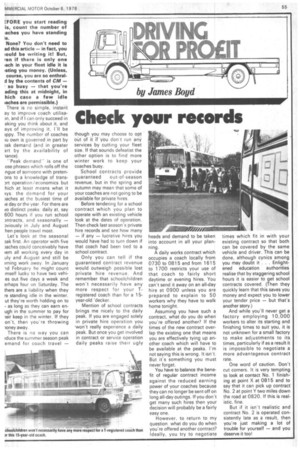Check your records
Page 59

If you've noticed an error in this article please click here to report it so we can fix it.
EFORE you start reading is, count the number of .aches you have standing le.
None? You don't need to ad this article — in fact, you iould be writing it! But, ren if there is only one 'itch in your fleet idle it is
sting you money. (Unless, course, you are so enthralcl by the contents of CM
so busy — that you're ading this at midnight, in hich case a few idle iaches are permissible.)
There is no simple, instant ay to improve coach utilisa)n, and if I can only succeed in eking you think about it, and ays of improving it, I'll be ippy. The number of coaches iu own is governed in part by ?ak demand (and in greater 3rt by the availability of lance).
"Peak demand" is one of ose phrases which rolls off the ngue of someone with pretenons to a knowledge of trans3rt operation /economics but hich at least means what it 3ys the demand for your )aches at the busiest time of le day or the year. For there are vo distinct peaks daily at, say 600 hours if you run school 3ntracts, and seasonally — 3viously in July and August hen people travel most.
Let's look at the seasonal 3ak first. An operator with five mches could conceivably have iem all working every day in Lily and August and still be iming work away. In January id February he might count rnself lucky to have two vehies out five days a week and erhaps four on Saturday. The thers are a liabilty when they re standing idle in the winter, ut they're worth holding on to as long as they can earn enugh in the summer to pay for ieir keep in the winter. If they on't, then you're throwing loney away.
There is no way you can 3duce the summer season peak emand for coach travel —
though you may choose to opt out of it if you don't run any services by cutting your fleet size. If that sounds defeatist the other option is to find more winter work to keep your coaches busy.
School contracts provide guaranteed out-of-season revenue, but in the spring and autumn may mean that some of your coaches are not going to be available for private hires.
Before tendering for a school contract which you plan to operate with an existing vehicle look at the dates of operation. Then check last season's private hire records and see how many — if any — lucrative hires you would have had to turn down if that coach had been tied to a school contract.
Only you can tell if the guaranteed contract revenue would outweigh possible lost private hire revenue. And remember that schoolchildren won't necessarily have any more respect for your Tregistered coach than for a 15year-old 'decker.
Mention of school contracts brings me nicely to the daily peak. If you are engaged solely in private hire operation you 'won't really experience a daily Peak. But once you get involved in contract or service operation daily peaks raise their ugly heads and demand to be taken into account in all your planning.
A daily works contract which occupies a coach locally from 0730 to 0815 and from 1615 to 1700 restricts your use of that coach to fairly short daytime or evening hires. You can't send it away on an all-day hire at 0900 unless you are prepared to explain to 50 workers why they have to walk home tonight.
Assuming you have such a contract, what do you do when you're offered another? If the times of the new contract overlap the existing one that means you are effectively tying up another coach which will have to be available at the peaks. I'm not saying this is wrong. It isn't. But it's something you must never forget.
You have to balance the benefit of regular contract income against the reduced earning power of your coaches because they can no longer be sent off on long all-day outings. If you don't get many such hires then your decision will probably be a fairly easy one.
However, to return to my question what do you do when you're offered another contract? Ideally, you try to negotiate times which fit in with your existing contract so that both can be covered by the same vehicle and driver. This can be done, although cynics among you may doubt it . . Enlightened education authorities realise that by staggering school hours it is easier to get school contracts covered. (Then they quickly learn that this saves you money and expect you to lower your tender price — but that's another story.) And while you'll never get a factory employing 10,000 workers to alter its starting and finishing times to suit you, it is not unknown for a small factory to make adjustments to its times, particularly if as a result it is impossible to negotiate a more advantageous contract rate.
One word of caution. Don't cut corners. It is very tempting to look at contact No. 1 finish-' ing at point X at 0815 and to say that it can pick up contract No. 2 at point Y two miles down the road at 0820. lf this is realistic, fine.
But if it isn't realistic and contract No. 2 is operated consistently late as a result, then you're just making a lot of trouble for yourself — and you deserve it too!


























































































































































